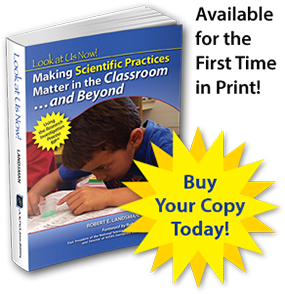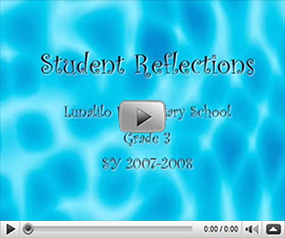Scientific Practices & Scientific Inquiry
Scientific inquiry is made up of a number of behavior and thinking actions, or practices, termed “scientific practices.” In fact, “scientific practices” is sometimes defined by Next Generation Science Standards (NGSS) committee members as “scientific inquiry unpackaged.” RIP® scientific inquiry introduces to the students the scientific and engineering practices and sustains the use of these practices within a critical thinking model based on investigation and scientific practices. This model combines the use of the scientific and engineering practices to leverage the inquiry process as a critical thinking and learning model for all content areas. Thus, within Look at Us Now! Making Scientific Practices Matter in the Classroom…and Beyond are inquiries focused directly on language arts, mathematics, social studies, and cultural arts subject content.
RIP-based scientific inquiry also encourages and in many cases requires the use of ALL of the NGSS scientific practices within a single learning unit or investigation. Thus, as the reader will learn, even Kindergarten students employ and become proficient (at a developmentally-appropriate level) in the eight scientific (or engineering) practices.
"In the future, science assessments will not assess students’ understanding of core ideas separately from their abilities to use the practices of science and engineering. They will be assessed together, showing students not only 'know' science concepts; but also, students can use their understanding to investigate the natural world through the practices of science inquiry, or solve meaningful problems through the practices of engineering design" (Next Generation Science Standards: APPENDIX F– Science and Engineering Practices in the NGSS).
What are the Eight Scientific Practices and Engineering Practices?
The eight practices of science and engineering contained within the Framework (NRC, 2012; from which the NGSS originated) and NGSS essential for all students to learn are:
- Asking questions (for science) and defining problems (for engineering)
- Developing and using models
- Planning and carrying out investigations
- Analyzing and interpreting data
- Using mathematics and computational thinking
- Constructing explanations (for science) and designing solutions (for engineering)
- Engaging in argument from evidence
- Obtaining, evaluating, and communicating information
The guiding principles contained in the NGSS (Achieve, 2013) state "Students in grades K - 12 should engage in all eight practices over each grade band." The reader of Look at Us Now! will recognize these practices occurring over and over again within each investigation and across the chapters.
Equally important to understanding the scientific and engineering practices is the ability to achieve them in the classroom through investigation-based curriculum. For this to happen, it is necessary to recognize and understand the changes and adjustments required for appropriate classroom conditions to occur. This is precisely what Look at Us Now! accomplishes for the reader. Within each chapter, the teacher authors not only identify the conditions they established towards achievement of a learning and instructional environment conducive to standards-based learning [the National Science Education Standards’ (NSES’) More Emphasis conditions], but also explain what they put into place, changed or adjusted to actually accomplish these conditions.
"Standards and performance expectations that are aligned to the framework must take into account that students cannot fully understand scientific and engineering ideas without engaging in the practices of inquiry and the discourses by which such ideas are developed and refined" (National Research Council Framework for the Next Generation Science Standards, 2012, p. 218).
Please visit anovascience.com to learn more about the RIP model.
Your Shopping Cart
Ordering five (5) or more copies? Contact us for a special volume discount.
Read the Foreword
Enter your name and e-mail address below for immediate access to read the complete Foreword, written by Dr. Robert E. Yager, in its entirety.


 ANOVA Science
ANOVA Science